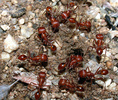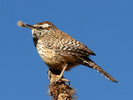Introduction
This portfolio instructs on Sonoran Desert Biodiversity with two modules: The Arthropod Investigation and the Habitat Investigation. Each module:
- is aligned to AZ State Standards grades 3-12
- presents hands on investigations
- has background information and explanation of investigations in text and multimedia format
- shares ways to document, analyze and report data as well as technology integration tips
- contains information on student scientists and professors at the University of Arizona
Portfolio Pages
Arthropod Investigation
- Arthropod Investigation
-
 © 2003 Alex Wild
© 2003 Alex Wild
- - Learn how to create pitfall traps for sampling arthropod diversity. - Study microhabitats in your schoolyard. - Learn about biologists who study arthropod diversity.
Habitat Investigation
- Habitat Investigation
-
 © 2007 Glenn Seplak
© 2007 Glenn Seplak
- - Sample arboreal arthropods - Identify of common local bird species - Test the biodiversity sampling effect with real data -Record and Graph data -Analyze diversity data from the Tucson Bird Count And More!
- Reconciliation Ecology
-
 © Bert Lippel
© Bert Lippel
Identification Support
Information on the Internet
- Arthropods in Their Microhabitats American Museum of Natural History (AMNH) Get ready for an ant's eye-view of the world. Students learn techniques for observing, identifying, and classifying arthropods within a microhabitat; they'll also learn how to trap specimens, and how to kill and preserve specimens for further study. Students apply these skills to their own field sites as part of a study of local biodiversity, finding out exactly how biodiverse is each microhabitat within their site, and graphing their findings.
- Biodiversity Counts Welcome to Biodiversity Counts! This special resource collection takes students into the field and engages them in life science research: the inventory of plants and arthropods outside their own backdoors. Resources in this collection include lesson plans, profiles of scientists and Museum staff, essays, and Web-based interactives that help students explore, analyze, and apply their field observations.
- Ecology Explorers Doing Science in Your Schoolyard. Part of Arizona State University's Global Institute for Sustainability








 Go to quick links
Go to quick search
Go to navigation for this section of the ToL site
Go to detailed links for the ToL site
Go to quick links
Go to quick search
Go to navigation for this section of the ToL site
Go to detailed links for the ToL site